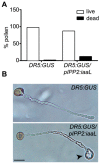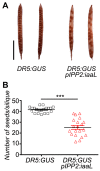Modulation of Auxin Levels in Pollen Grains Affects Stamen Development and Anther Dehiscence in Arabidopsis
- PMID: 30131475
- PMCID: PMC6164920
- DOI: 10.3390/ijms19092480
Modulation of Auxin Levels in Pollen Grains Affects Stamen Development and Anther Dehiscence in Arabidopsis
Abstract
Auxin regulates diverse aspects of flower development in plants, such as differentiation of the apical meristem, elongation of the stamen, and maturation of anthers and pollen. It is known that auxin accumulates in pollen, but little information regarding the biological relevance of auxin in this tissue at different times of development is available. In this work, we manipulated the amount of free auxin specifically in developing pollen, using transgenic Arabidopsis lines that express the bacterial indole-3-acetic acid-lysine synthetase (iaaL) gene driven by a collection of pollen-specific promoters. The iaaL gene codes for an indole-3-acetic acid-lysine synthetase that catalyzes the conversion of free auxin into inactive indole-3-acetyl-l-lysine. The transgenic lines showed several abnormalities, including the absence of short stamina, a diminished seed set, aberrant pollen tubes, and perturbations in the synchronization of anther dehiscence and stamina development. This article describes the importance of auxin accumulation in pollen and its role in stamina and anther development.
Keywords: anther; auxin; dehiscence; iaaL; pollen.
Conflict of interest statement
The authors declare no conflict of interest.
Figures







Similar articles
-
Auxin regulates Arabidopsis anther dehiscence, pollen maturation, and filament elongation.Plant Cell. 2008 Jul;20(7):1760-74. doi: 10.1105/tpc.107.057570. Epub 2008 Jul 15. Plant Cell. 2008. PMID: 18628351 Free PMC article.
-
ABCB1 and ABCB19 auxin transporters have synergistic effects on early and late Arabidopsis anther development.J Integr Plant Biol. 2015 Dec;57(12):1089-98. doi: 10.1111/jipb.12332. Epub 2015 Mar 16. J Integr Plant Biol. 2015. PMID: 25626615
-
Auxin flow in anther filaments is critical for pollen grain development through regulating pollen mitosis.Plant Mol Biol. 2006 May;61(1-2):215-26. doi: 10.1007/s11103-006-0005-z. Plant Mol Biol. 2006. PMID: 16786302
-
The final split: the regulation of anther dehiscence.J Exp Bot. 2011 Mar;62(5):1633-49. doi: 10.1093/jxb/err014. Epub 2011 Feb 16. J Exp Bot. 2011. PMID: 21325605 Review.
-
Auxin regulation of Arabidopsis flower development involves members of the AINTEGUMENTA-LIKE/PLETHORA (AIL/PLT) family.J Exp Bot. 2011 Jun;62(10):3311-9. doi: 10.1093/jxb/err127. Epub 2011 Apr 21. J Exp Bot. 2011. PMID: 21511900 Review.
Cited by
-
Auxin guides germ-cell specification in Arabidopsis anthers.Proc Natl Acad Sci U S A. 2021 Jun 1;118(22):e2101492118. doi: 10.1073/pnas.2101492118. Proc Natl Acad Sci U S A. 2021. PMID: 34031248 Free PMC article.
-
Comparative Metabolic Analysis Reveals a Metabolic Switch in Mature, Hydrated, and Germinated Pollen in Arabidopsis thaliana.Front Plant Sci. 2022 May 18;13:836665. doi: 10.3389/fpls.2022.836665. eCollection 2022. Front Plant Sci. 2022. PMID: 35665175 Free PMC article.
-
Responses of differential metabolites and pathways to high temperature in cucumber anther.Front Plant Sci. 2023 Apr 14;14:1131735. doi: 10.3389/fpls.2023.1131735. eCollection 2023. Front Plant Sci. 2023. PMID: 37123826 Free PMC article.
-
Transcriptome profiling of the fertile parent and sterile hybrid in tea plant flower buds.Hereditas. 2019 Apr 18;156:12. doi: 10.1186/s41065-019-0090-z. eCollection 2019. Hereditas. 2019. PMID: 31019434 Free PMC article.
-
Hormonome Dynamics During Microgametogenesis in Different Nicotiana Species.Front Plant Sci. 2021 Oct 15;12:735451. doi: 10.3389/fpls.2021.735451. eCollection 2021. Front Plant Sci. 2021. PMID: 34721464 Free PMC article.
References
MeSH terms
Substances
LinkOut - more resources
Full Text Sources
Other Literature Sources

